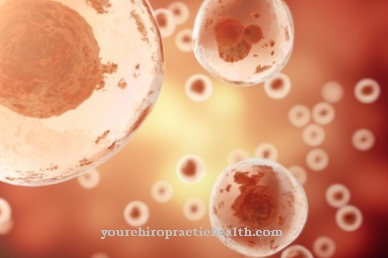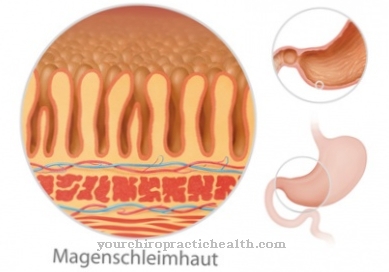Of the Pulmonary circulation, also small bloodstream called, is part of the human cardiovascular system. It regulates the transport of blood between the heart and the lungs and is used for gas exchange, i.e. the absorption of oxygen into the blood and the release of carbon dioxide into the air we breathe.
What is pulmonary circulation?

The heart is the drive pump for the human organism's transport system, the so-called blood circulation. Its function is to supply the organs and tissue with oxygen and nutrients as well as the removal of metabolic products.
This transport system, also known as the cardiovascular system, is made up of two sub-circuits: the large body circulation and the small pulmonary circulation. Both circuits are functionally coordinated in such a way that the used blood is first transported through the lungs for oxygen enrichment before it reaches the different regions of the body again.
The blood that feeds the pulmonary circulation comes from the right half of the heart. It is pumped through an arterial vascular system into the capillaries of the lungs, where oxygen is absorbed from the breath into the blood and at the same time carbon monoxide is released from the blood into the breath. This exchange of oxygen and carbon dioxide is called gas exchange. The blood, which is now oxygenated, is transported back via the pulmonary veins and ends in the left half of the heart, where the body's circulation begins.
Function & task
The used, i.e. oxygen-poor, blood is returned to the right half of the heart via the two large hollow veins. It flows from the forecourt into the right main chamber. This forms the starting point of the pulmonary circulation. As the heart muscle contracts during the expulsion phase, the blood is pumped through the opening pulmonary valve into the large pulmonary trunk, which splits into the left and right pulmonary arteries. These lead to the right and left lungs. There they branch out according to the anatomical structure of the lungs in the so-called lung lobes and lung segments into ever finer arteries, up to arterioles, and finally open into the capillary vessels. The capillaries surround the alveoli, which are filled with air and which attach to the ends of the bronchioles, like a dense network.
During the process of breathing, gas is exchanged between the alveolar air and the blood in the capillaries. The alveoli and capillary vessels are only separated by a thin, selectively permeable wall. By means of diffusion, carbon dioxide can therefore be released from the blood into the alveoli and exhaled. On the other hand, the inhaled oxygen can be absorbed from the alveoli into the blood.
The oxygen-rich blood is transported back to the heart via a venous system that runs between the individual lung segments. So-called venules, i.e. the smallest veins, first collect the blood from the capillaries and then unite to form increasingly larger veins, which ultimately flow into the large pulmonary vein. This leads the blood to the left atrium, from where it reaches the left ventricle and is discharged to the periphery of the body via the body's circulation.
The vascular system of the pulmonary circulation is called the Vasa publica. Compared to the vessels that supply the lungs themselves with oxygen, the so-called vasa privata, it serves the entire organism by enabling gas exchange, i.e. the absorption of oxygen and the release of carbon dioxide.
Illnesses & ailments
The vital gas exchange during the pulmonary circulation can be disturbed by various clinical pictures, which cause a reduced oxygen saturation and an excess of carbonic acid in the blood. The undersupply of oxygen usually manifests itself in those affected by rapid fatigue, shortness of breath and shortness of breath up to dizziness and a bluish discoloration of the skin and lips. Even organ damage can result. The body tries to counteract the acute deficiency with an increased breathing and heart rate.
Pulmonary emphysema, a chronic disease of the lungs, is responsible for such a gas exchange disorder. The flow of breath is obstructed because the inhaled air is, so to speak, stuck in the alveoli. The reason for this lies in an irreversible enlargement of the alveoli due to the enzymatic destruction of the partition walls that serve for gas exchange.
Pulmonary edema describes a condition in which water collects in the lungs. More precisely, liquid penetrates from the capillary vessels into the alveoli, which severely affects gas exchange. Pulmonary edema can be caused by acute pump failure in the left half of the heart, kidney failure and severe allergic reactions, but also dangerously low oxygen partial pressure in the ambient air at altitudes above 3000 meters.
Other serious diseases that affect the vessels in the lungs are pulmonary hypertension and pulmonary embolism. Pulmonary hypertension, also known as pulmonary arterial hypertension, is characterized by chronically increased pulmonary arterial pressure. This high blood pressure in the pulmonary artery can be attributed to a narrowing of the blood vessels and an associated increased vascular resistance. The consequence is a poor oxygen supply and an increased, compensatory pumping capacity of the heart. Especially the right half of the heart, which can lead to right heart failure.
A pulmonary embolism is the occlusion of a pulmonary artery by the body's own or foreign objects, which triggers a pulmonary infarction with tissue damage. The extent of the damage depends on the size of the artery affected and can be life-threatening. The vascular blockage is mostly caused by thrombi, i.e. small blood clots that return from the leg or pelvic veins.












.jpg)



.jpg)










.jpg)
